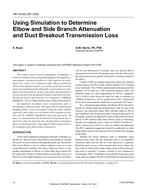Description
The primary path of noise propagation in buildings is airborne transmission from building equipment through ducts.Attenuation is increased if elbows or side branches are introduced into a duct. In a companion paper (Ruan and Herrin2016), finite element analysis was used to predict the insertion losses of straight lined and unlined ducts and results were validatedwith measurement. In this work, finite element analysis is used to predict the attenuation of elbows and side branches.Results for elbows and branches are compared to ASHRAE Handbook—HVACApplicationsvalueswithgoodagreement.An important secondary noise transmission path is through duct walls into rooms. This path, which is often termedbreakout noise, is also investigated using the finite element approach, and results are correlated with an analytical solutionand the ASHRAE Handbook with good agreement. Of note, it is demonstrated that the breakout transmission loss ismuch less than the insertion loss through lined rectangular ducts at some frequencies. This suggests that breakout noise isthe dominant noise path at these frequencies.
Citation: 2016 Winter Conference, Orlando, FL, Transactions 2016, Vol 122 pt. 1
Product Details
- Published:
- 2016
- Number of Pages:
- 10
- Units of Measure:
- Dual
- File Size:
- 1 file , 3.4 MB
- Product Code(s):
- D-OR-16-002




